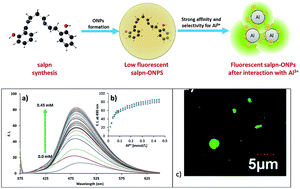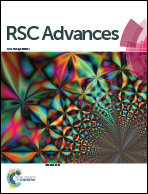Fluorescent organic nanoparticles (FONs) for selective recognition of Al3+: application to bio-imaging for bacterial sample†
Abstract
The development of a novel chemo-sensor for the detection of Al3+ with high sensitivity in aqueous solution is widely considered an important research goal because of the importance of such probes in medicine, living systems and the environment. In this work, we describe a new fluorescent probe, a Schiff's base N,N′-propylenebis(salicylimine) (salpn) as fluorescent organic nanoparticles for Al3+. The study shows that salpn detects Al3+ with the detection limit as low as 1.24 × 10−3 mM, indicating that the chemo-sensor has high sensitivity in aqueous medium, and the fluorescence intensity increases with the increasing Al3+ concentration in the presence of the salpn-ONPs which act as chemo-sensors. The interference of common coexistent metal ions such as Mn2+, Mg2+, Co2+, Fe3+, Ni2+, Zn2+, Sr2+, Ag+, Sm3+, Al3+, Cd2+, Ba2+, Na+ and K+ was tested, showing that salpn-ONPs efficiently detect Al3+ ions with small interference from Cu2+ and Cr3+. Finally, the efficiency of salpn to as a fluorescent probe for Al ion in living systems was evaluated in Gram-negative and Gram positive bacteria, and con-focal laser scanning microscopy confirms its utility that this chemo-sensor efficiently detects Al3+ ion in Staphylococcus aureus enclosed by a single membrane.


 Please wait while we load your content...
Please wait while we load your content...